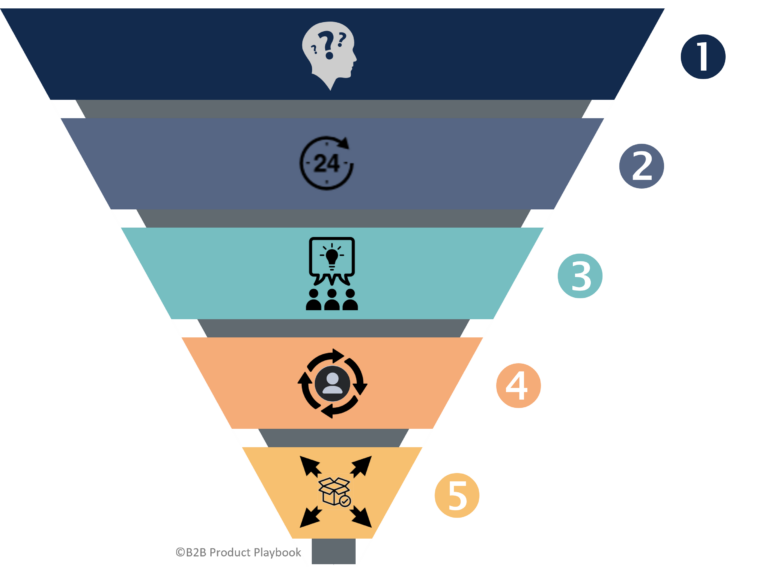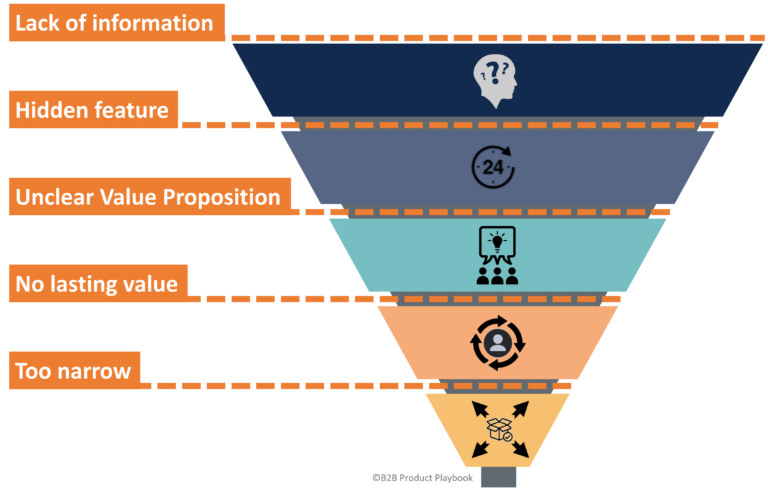A B2B Metrics Framework
Issues with the Pirate Metrics Framework
We have discussed Pirate Metrics, a popular framework helping to monitor the health of the business by means of systematic metrics:
Acquisition
Activation
Retention
Referral
Once sold, referrals are less relevant because more often than not employees have to use a certain tool to complete a certain job. It’s not their choice.
In Sales, reference customers help a lot – but typically these come from managers, require approval by their marketing teams, and such.
Revenue
Enterprise Sales works differently, with long-term contracts, 6- or even 7-digit contract values, step-up deals, and other contractual agreements. Also, pricing is influenced by many options rather than a one-size-fits-all approach.
Consequently, it is often hard for Product Management to influence the revenue directly based on some metrics.
Awareness
Target users know about the product or feature. Note that this includes two distinct levels: Corporate customers know about our product so they can include us in their buying decision; but also the actual users need to know about (new) features so they can actually benefit from these.
Availability
A product or feature is technically available to users which includes the actual Distribution of the tool but also considers aspects such as dedicated licensing or access permissions. For example, a premium feature might not be visible until licensed which also hinders users from being aware of it – a vicious circle.
Aha! Moment
Retention
Using the product or feature provides enough benefit to users so that they become repeat users. Note that the cadence might vary significantly, some jobs have to be completed daily, others only once a quarter or even once a year resulting in slow data when measuring retention.
Expansion
Example Metrics
- Awareness can be determined based on brand awareness studies which are regularly conducted by independent analysts or research companies. To some extent, this bypasses the licensing issue mentioned above by addressing the market before a deal is actually closed.
For existing customers, measure how many of the target users you truly reach with release notes, feature announcements, and other marketing campaigns. - Availability takes into account how many users really have access, so for how many of them are relevant licenses or devices activated, are permissions granted, etc.?
- The Aha! Moment can be measured by the number of users who actively used a product or feature, so they used it at least once during a given time period after launch.
- Retention refers to the number of times a product or feature has been used over a certain time period. This is usually easy to measure unless data privacy concerns prevent collecting data on the user level. Make sure to take the typical cadence of a job-to-be-done into account, e.g. when (non-)financial reports are only due quarterly or even yearly. Also, when a job is typically only addressed by specialists, segment your users accordingly.
- For expansion, standard metrics like customer retention or, even better, Net Retention Rate, can be used. If needed, Product Managers can distinguish between expansion based on up-sell vs. cross-sell. Other than the initial deal, expansion can very well be supported by and measured inside the product.
As explained above, it is essential that the specific metrics fit both, the target market as well as the product. A tool that is used daily by office workers (say Office 365) needs different metrics than a product only used occasionally by deskless workers (say inspection tools for offshore wind farms).
Furthermore, such metrics require constant review and adjustments to serve as meaningful indicators guiding he Product Management team.
Barriers and Howe to Overcome Them
Measuring the above is only a first step. It is important to consider the framework as a funnel and understand which barriers keep moving users from one stage to another. A few examples are depicted below:
Going a bit deeper, different strategies can be derived to overcome these barriers:
Achieving Awareness
As sketched above, lack of information is a main barrier. There are many underlying root causes which require specific actions:
Focus on Marketing to spread the word. Talk to analysts and independent research companies to make yourself known. Visit events, trade fairs, etc. of target customers. You need to break the vicious circle so that target customers visit at least your website, if not your product.
Prospects, customers, and even existing users might not be aware of the provided functionality, specifically when it has been added recently.
Apart from trade fairs and other Marketing campaigns, organize product webinars. Ideally, run general webinars around major releases providing a general overview – and accompany these with deep dive sessions on specific topics for the respective expert users. Ensure that questions can be addressed in open Q&A sessions.
However, be realistic. Only a relatively small fraction of customers will attend. Some more can be reached by sending them release notes or recordings of the webinars. But, still, a vast majority will opt out.
From Awareness to Availability
Even when users know about the product or feature, e.g. by following your release communication, they might not be able to access and try.
The product or feature might be a premium feature that requires payment or otherwise granting access.
Borrowing from Product-led Growth, offer free trials by allowing to use a new feature a few times before licensing is required. If that is not possible for whatever reason, use in-product tours, short videos, and similar material to inform users. Ideally, they will reach out to you and ask to get access.
From Availability to the Aha! Moment
Even when users know, they might not understand the value of a product or feature. Or maybe they forgot about it because they only use it occasionally?
Hey, it seems you were trying to achieve... Click here to learn about a faster way of doing this.
You need to be highly specific, though. Don’t annoy users by flooding them with disturbing messages (Office Clippy, anyone?). On the other hand, when you manage to catch and truly support users in that very same moment they are struggling, this can be very powerful.
From the Aha! Moment to Retention
Specifically occasional users might have used a product or feature before but not be aware of it next time on the job.
Another aspect, specifically in B2B, is that the job-to-be-done is typically bound to a role or position. So, employees might change roles or get promoted, new employees come in, and they need to take over these jobs, lacking the experience of the previous position holder.
Observe such organizational changes. Most often in B2B, org charts and similar data is made available via integrations with HR systems. Maybe you can somehow educate the successor in the position of what the previous person has been using?
From Retention to Expansion
Maybe the job is too complicated and can only be conducted by a few experts? Then try to make the job easier with your product so that experts can delegate to more users.
Or maybe your customers grew, they now have many more employees than before, and they are just not onboarded? Typically, such situations are handled by Account Management but inside the product make sure that onboarding is as simple as possible, including standard features like SSO.
Be aware that different user personas might require different experiences. Specifically when switching from office workers to deskless workers, from digital natives to users less experienced in using digital tools, then you may have to adapt your product experience.
For the Product Management team, it might become an option to build dedicated tools, apps, or landing pages for these different user groups and then target users based on their roles.




